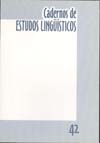Resumo
This paper analyses the ideologies underlying western thinking on speech in terms of the metaphorical use of two notions: the alphabet and the machine. It is argued that a subtle cooperation between these two metaphors underlies not only scientific but also technological work on speech – and, indirectly, language. Such ideologies are so deeply rooted in academic practice that attempts at solving the mind-body problem that do not incorporate them tend to be relegated to silence. This silence is shown to serve the same interests as other, more violent, ways of denying the inherent dignity of the human body. The historical status of current phonetic theories related to psychological theories that reject such metaphors is discussed in this light.Referências
BARBOSA, P.A. (2001). Generating duration from a cognitively plausible model of rhythm production. Proceedings EuroSpeech’01. V.2, 967-970. Aalborg-Dinamarca.
BARBOSA, P.A. (no prelo). Máquinas falantes como instrumentos lingüísticos: por um humanismo éclairé. Línguas e Instrumentos Lingüísticos.
BELL, A. M. (1867). Visible Speech – The Science of Universal Alphabetics. Nova Iorque: van Nostrand.
BROWMAN, C. e L. Goldstein. (1986). Towards an articulatory phonology. Phonology Yearbook 3: 219252.
BROWMAN, C. (1989). Articulatory gestures as phonological units. Phonology Yearbook, 6: 201-251.
BROWMAN, C. (1990). Tiers in articulatory phonology. In: Kingston e Beckman (orgs.). Papers in laboratory phonology: between the grammar and the physics of speech. pp. 341-376. Cambridge University Press.
BROWMAN, C. (1992). Articulatory phonology: an overview. Phonetica, 49: 155-180.
CHOMSKY, N. (1968). Language and mind. Nova Iorque: Harcourt Brace Jovanovich.
CHOMSKY, N. (1986). Knowledge of language: its nature, origin and use. Nova Iorque: Praeger.
COURDEMOY, G. (1666). Discours physique de la parole. Paris: Bibliothèque du Graphe, edição facsimile, 1970.
DERRIDA, J. (1972). Marges de la philosophie. Collection critique. Paris: Minuit.
DUDLEY, H. (1939). Remaking speech. Journal of the Acoustical Society of America 11:169.
DUDLEY, H.; R. Riez e S. Watkins. (1939). A synthetic speaker. Journal of the Franklin Institute, 227: 739–764.
DUDLEY, H., e T. Tarnoczy. (1950). The Speaking Machine of Wolfgang of von Kempelen. Journal of the Acoustical Society of America, 22 (2): 151–166.
FANT, G. 1960. Acoustic theory of speech production. Haia: Mouton.
HEFFNER, R. (1950). General Phonetics. Madison: the Wisconsin University Press.
JONES, D. (1957). The history and meaning of the term ‘phoneme’. Le Maître Phonétique, supplement.
KELSO, J.A.S. (1995). Dynamic patterns: the self-organization of brain and Behavior. Cambridge: MIT Press
KOHLER, K. (1995). Phonetics: a language science in its own right? In: Elenius e Branderud (orgs.). Proceedings of the XIIIth Congress of Phonetic Sciences, vol. 1, pp. 10-17. Estocolmo: Universidade de Estocolmo e Instituto Real de Tecnologia.
KÖHLER, W. (1947). Gestalt Psychology. Nova Iorque: Liveright.
KUGLER, P. e M. Turvey. (1987). Information, natural law and the self-assembly of rhythmic movement. Hillsdale: Lawrence Erlbaum.
LACAN, J. (1971). Écrits II. Paris: Éditions du Seuil.
NOLAN, F. (1999). The devil is in the detail. In: Ohala J., Hasegawa Y., Ohala M., Granville D., Bailey A. (eds.), Proceedings of the XIVth International Congress of Phonetic Sciences. Berkeley: University of California at Berkeley, vol. I, 1-8.
PÊCHEUX, M. (1983). Discurso: estrutura ou acontecimento. Campinas: Pontes.
PIAGET, J. (1956 [1923]). Le langage et la pensée chez l’enfant. Neuchâtel: Delachaux et Niestlé.
PIKE, K. (1943). Phonetics. A critical analysis of phonetic theory and o technic for the practical description of sounds. Ann Arbor: University Michigan Press.
PIKE, K. (1957). Phonemics: a technique for reducing languages to writing. Ann Arbor: University of Michigan Press.
ROSETTI, A. (1957). Introdução à Fonética. Lisboa: Europa-América.
STETSON, R. (1928). Motor Phonetics. Extrait des Archives Néerlandais de Phonétique Expérimentale.
STETSON, R. (1945). Bases of Phonology. Oberlin: Oberlin College.
SAPIR, E. (1957 [1925]). Sound pattern in language. In: M. Joos (org.). Readings in linguistics I: the development of descriptive linguistics in America. pp. 19-25. Chicago: the University of Chicago Press.
SCRIPTURE, E. 1973 [1902]. The elements of experimental phonetics. Nova Iorque: AMS Press, Inc.
STAROBINSKI, J. (1971). As palavras sob as palavras: os anagramas de Ferdinand de Saussure. São Paulo: Perspectiva.
THELEN, E. (1995). Time-scale dynamics and the development of an embodied cognition. In: R. Port e T. van Gelder. Mind as motion: explorations in the dynamics of cognition. Cambridge: MIT Press, pp. 69-100.
TULLER, B., P. Case, M. Ding e. S. Kelso (1994). The non linear dynamics of categorical perception. Journal of Experimental Psychology: Human Perception and Performance, 20(1): 3 – 16.
TULLER, B. e Kelso, J.A.S. (1991). The production and perception of syllable structure. Journal of Speech and Hearing Research, 34: 501-508.
VYGOTSKY, L. S. (1962 [1934]). Thought and language. Cambridge: MIT Press
TRUBETZKOY, N. 1964 [1939]. Principes de phonologie. Paris: Klincksieck.
TRUBETZKOY, N. 1981 [1933]. A Fonologia atual. In: Dascal, M. Fundamentos metodológicos da Lingüística, vol. II, Fonologia e Sintaxe, pp. 15-35.
WILKINS, J. (1668). An Essay towards a Real character and Philosophical Language.
VON KEMPELEN, W.R. (1791). Mechanisms der menschliche. Sprache nebst der Beschreibung seiver sprechenden Maschine.
O periódico Cadernos de Estudos Linguísticos utiliza a licença do Creative Commons (CC), preservando assim, a integridade dos artigos em ambiente de acesso aberto.

